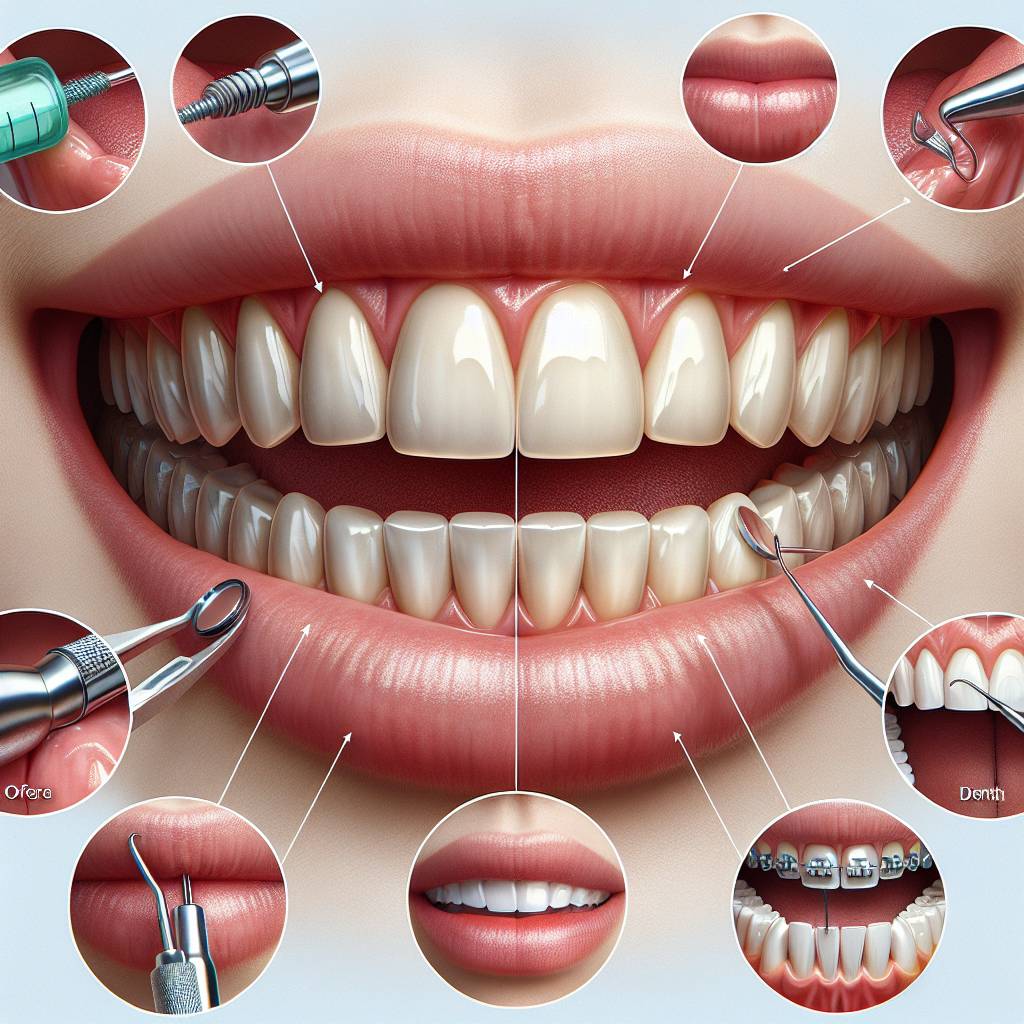Gap teeth are a common dental concern that can be quickly and easily corrected with the help of orthodontic treatment. Orthodontists can provide treatments that involve braces, clear aligners, or other appliances to move the teeth into the desired position. Depending on the severity of the gap and the goals of treatment, it typically takes anywhere from six months to two years to fix gap teeth. This time frame may vary based on an individual’s age, compliance with treatment protocols, and other factors. In this article, we will discuss how long it takes to fix gap teeth and tips for making treatment more efficient.Gap teeth is a condition where there is a space between two or more of the front teeth. Gap teeth can be caused by genetics, thumb-sucking, or improper dental hygiene. Some people with gap teeth may choose to have braces or other dental treatments to correct the condition.
Factors Influencing Treatment Time
The length of time it takes to complete a treatment depends on a variety of factors. These can include the type of treatment being received, the complexity of the underlying condition, and the patient’s overall health. Additionally, the availability of resources and the skill level of the healthcare provider may also influence how long a treatment takes.
The type of treatment is an important factor since different treatments may take different amounts of time to complete. For example, a minor procedure such as filling a cavity may take just one visit to complete while more complex treatments such as orthodontic braces may take months or even years to complete.
The complexity of an underlying condition can also influence treatment time. If a patient is suffering from a serious illness or injury, it may take longer for them to heal than if they were healthy. Additionally, some conditions are more difficult to treat than others and thus require more time and effort from healthcare providers.
Finally, the availability of resources and the skill level of healthcare providers can also affect how long it takes for a treatment to be completed. If there are not enough resources available or if medical staff lack experience in treating certain conditions, then it may take longer for patients to receive effective care. Furthermore, if patients do not adhere to their treatment plan or do not follow instructions properly then this could also extend treatment time.
Options for Treating Gap Teeth
Gap teeth, also known as diastema, is a common condition in which there is a wide gap between two or more adjacent teeth. Treatment for gap teeth can range from simple lifestyle changes to more extensive options like braces and surgery. Here are some of the most commonly used methods of treating gap teeth:
Braces: Braces are the most common treatment for gap teeth. They can be used to slowly close the gap between two or more teeth. This process is often slow and may take several years to complete. Braces can also help improve the overall alignment of the teeth in the mouth.
Dental Bonding: Dental bonding is another option for treating gap teeth. In this procedure, a tooth-colored composite resin material is applied to the affected tooth or teeth. Once applied, it will be shaped and hardened with a special light so that it blends in with your natural smile. Dental bonding can be used to close gaps between two or more teeth and improve their overall appearance.
Veneers: Veneers are thin shells made of porcelain that are custom-made to fit over existing teeth. They can be used to fill gaps between two or more adjacent teeth and provide an improved aesthetic look while also protecting underlying natural tooth structure from further damage or decay.
Orthodontic Surgery: Orthodontic surgery may be an option if other treatments have not been successful in closing gaps between two or more adjacent teeth. During orthodontic surgery, a surgeon will reposition the affected tooth or teeth and then use braces or other orthodontic appliances to hold them in their new position until they become stable enough to stay put without any additional assistance.
No matter which treatment you choose, it’s important to talk with your dentist about your options so that you can make an informed decision about which one is best for you based on your individual needs and goals.
Orthodontic Braces and Alignment Treatments
Orthodontic braces and alignment treatments are a form of dentistry that helps to correct misalignments in the teeth or jaws. Orthodontics is used to treat a variety of issues, such as underbites, overbites, crooked teeth, gaps between teeth, and other malocclusions. Orthodontic braces can be used to slowly move the teeth into a better position. This process can take anywhere from six months to two years depending on the severity of the misalignment.
The process begins with an orthodontist creating impressions of the patient’s mouth and taking x-rays to determine the current state of alignment. From there, they will design a treatment plan that takes into account the individual’s needs and goals. The orthodontist will then fit the patient with braces or other orthodontic appliances such as aligners or retainers. These appliances work by putting pressure on the teeth in order to move them into their proper position over time.
In addition to traditional braces, there are also clear aligners which are made from clear plastic trays that are custom-fit to each individual’s mouth. Clear aligners are virtually invisible when worn and require fewer office visits than traditional braces because they do not need to be adjusted as often. However, these aligners may not be suitable for more severe misalignments or cases where tooth movement needs to be done quickly.
Regardless of which type of orthodontic treatment is chosen, it is important for patients to follow their dentist’s instructions carefully in order for treatment to be successful. This includes brushing regularly, avoiding hard foods that can damage brackets or wires, wearing mouthguards while playing sports or engaging in activities that could cause harm to the mouth area, and attending all scheduled checkups with their orthodontist in order for progress on treatment to be monitored closely. With proper care and regular follow-up visits with their dentist, patients can enjoy a straighter smile in no time at all!
Having Veneers or Bonding Installed
Veneers and bonding are two popular cosmetic dentistry treatments that can be used to improve the appearance of teeth. Both treatments involve the use of a composite resin material that is applied directly to the tooth surface. With veneers, the resin is applied to the front of the tooth and shaped into a thin shell, while with bonding, it is applied directly to the tooth surface and then sculpted into shape. The result in both cases is a natural looking smile with improved aesthetics.
The process of having veneers or bonding installed begins with an examination by your dentist, who will assess your teeth and determine which type of treatment would be best suited for your individual needs. After that, impressions will be taken of your teeth so that custom-made veneers or bonding can be fabricated in a dental laboratory. Once they are ready, they will be bonded onto your teeth using a special dental adhesive.
The cost of having veneers or bonding installed can vary depending on the material used and the number of teeth being treated. Generally, porcelain veneers are more expensive than composite resin bonding but last longer as well. It’s important to discuss all aspects of treatment with your dentist before making a decision so that you can make an informed choice about which option is right for you.

Getting Dental Implants to Fix Gap Teeth
Gap teeth are a common dental issue that can significantly affect your appearance and self-confidence. Fortunately, there is a way to fix gap teeth using dental implants. Dental implants are the most reliable and long-lasting solution for replacing missing or damaged teeth. They are permanent replacements for missing teeth that look, feel, and function just like natural teeth. With proper care, they can last a lifetime.
Dental implants involve surgically placing artificial tooth roots called posts into the jawbone beneath your gums. These posts act as anchors for the replacement teeth which are attached to them during the procedure. The implant itself is made of titanium, a biocompatible material that integrates with your natural bone tissue over time. This helps create a strong and secure foundation for the replacement tooth or teeth.
The process of getting dental implants usually takes several visits to the dentist’s office over several months. During these visits, your dentist will check the progress of your healing and make sure everything looks good before proceeding with the next step. The final step is attaching the replacement tooth or teeth to the implant post using an abutment and crown which will be custom-made to match your natural smile.
Overall, getting dental implants is a great way to replace missing or damaged teeth and restore your smile’s appearance and function permanently. It requires a significant amount of time and money upfront, but it is worth it in the long run as it can make a huge difference in improving your quality of life. By following good oral hygiene habits, you can ensure that your dental implants last a lifetime.
Recovering After Having Gap Teeth Fixed
Having a gap in your teeth can be embarrassing and it can also cause long-term dental problems. If you have decided to have your gap teeth fixed, then you should know what to expect during the recovery period. This article will provide you with some tips on how to recover after having your gap teeth fixed.
The first step in the recovery process is to make sure that you follow all of your dentist’s instructions closely. Your dentist will likely provide you with a list of things that you should do after having your gap teeth fixed, such as refraining from eating hard or chewy foods and avoiding smoking or drinking alcohol. Following these instructions will help to ensure that your gap teeth are properly healed and that no further damage is done.
It is also important to take care of your oral hygiene during the recovery period. Brush and floss regularly and use a mouthwash to reduce bacteria levels in the mouth. This will help keep the area clean and free of infection while it heals. Additionally, if you experience any pain or discomfort after having your gap teeth fixed, speak with your dentist right away as they may need to adjust something in order for the healing process to go smoothly.
Finally, it is important to be patient during the recovery period as it can take several weeks for the area to fully heal. During this time it is best not to put too much pressure on the area as this could delay healing further. Additionally, you may also want to consider using an over-the-counter pain reliever such as ibuprofen if necessary, in order to manage any discomfort or pain that may occur during this time.
By following these tips, you should be able to make a full recovery after having your gap teeth fixed. Remember that it is important to follow instructions from your dentist closely and that patience is key when it comes to recovery periods such as this one. With proper care and attention, you should be able to enjoy a healthy smile soon!
How Long Does It Take To Fix Gap Teeth?
Gap teeth can be a source of self-consciousness for many people, and fixing them is a priority for many individuals. Depending on the individual’s case, it can take anywhere from a few weeks to several months to fix gaps in teeth. The time frame varies depending on the type of procedure used to close the gap.
The most common way to fix gap teeth is with orthodontic treatment, which usually takes several months or more. Orthodontic treatment typically involves braces or clear aligners to gradually move teeth into their correct positions. The length of time needed for braces or clear aligners depends on the individual’s situation and how severe their gap(s) is/are. Generally, braces are worn for about one year or longer, while clear aligners can take up to 18 months.
In some cases, porcelain veneers may be used to close gaps in teeth instead of orthodontic treatment. Veneers involve attaching thin shells of porcelain over existing teeth in order to cover gaps and reshape them into a desired shape and size. Although veneers are a faster option than braces or clear aligners, they still require multiple visits and can take up to two weeks to complete the process from start to finish.
For less severe cases, bonding may be an option instead of braces or veneers. Bonding involves using composite material that matches the color of existing teeth in order to fill in any gaps between them. This procedure usually takes only one visit and can be completed within an hour depending on how much bonding material needs to be applied.
Overall, there are various ways that gaps in teeth can be fixed but it is important for individuals considering any kind of treatment to consult with a dental professional first before making any decisions so that they can determine which type of treatment will work best for their individual needs.

Conclusion
Fixing gap teeth can take anywhere from one to several months depending on the severity of the case. While it may seem like a long time, the results are usually worth it in the end and you should be proud of yourself for taking action and improving your smile. Invisalign is the most popular method for closing gaps between teeth due to its effectiveness and convenience. However, traditional braces or bonding may also be used, depending on individual cases. No matter what method you choose, make sure to consult a qualified orthodontist who can assess your particular situation and provide you with guidance on what will work best for you.
At the end of the day, fixing gap teeth is an important step in achieving a beautiful smile that you can be proud of. The amount of time it takes may vary based on each individual case, but rest assured that it will be worth it when your dream smile comes to life!

